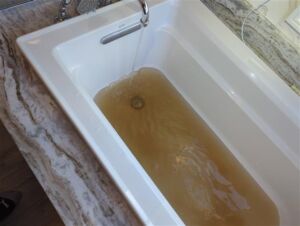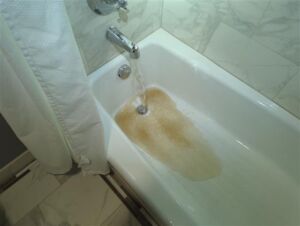The quality of water coming out of our plumbing fixtures is a key aspect of maintaining a healthy and comfortable home. When the water looks discolored, it can be alarming for the home owner or buyer. Most will start to ask questions about the water’s safety, origin, and potential impacts on both health and plumbing systems. In this article, we will explore the common reasons why water from plumbing fixtures might be discolored and also discuss possible solutions.
Sediment Accumulation:

Corrosion:
Corrosion within the plumbing system can also lead to discolored water. Aging iron and steel pipes typically corrode over time. Galvanized metal pipes are extremely common in homes that were built or remodeled in the 1960’s, 1970’s, and 1980’s. These pipes rust from the inside and the rust or other oxidized materials can give a reddish-brown tint to the water. Replacing corroded pipes is often the most effective fix for this problem. If the issue only happening at a specific fixture in the home, targeted replacement of pipes may be enough. If the home has old metal pipes, homeowners should consider repiping the entire system for a more comprehensive and long-term solution.
Municipal Water Supply Issues:
Discolored water can sometimes be caused by problems in the municipal water supply. Municipalities sometimes perform maintenance, repairs, or flushing of water mains, which can disturb sediment and cause temporary discoloration in the water that reaches the home. If the discoloration appears suddenly, contacting the local water utility can provide information about any ongoing maintenance or disruptions in the water supply. If the cause appears to be issues with the water supply coming in from the city, flushing the pipes by running cold water for a few minutes can help clear discolored water.
Presence of Minerals:

Conclusion:
Discolored water from plumbing fixtures can be a cause for concern, but often the solution can be found and addressed without too much difficulty. Understanding the underlying reason for the discolored water is the first step toward finding a solution. Whether the issue is related to sediment accumulation, corrosion in pipes, or mineral content, homeowners can take proactive measures to address and prevent discoloration. We recommend regular maintenance of plumbing systems in the home, testing water quality, and, if necessary, consulting with plumbing professionals to ensure a reliable and safe water supply in your home.
You can learn how to flush a water heater here:
